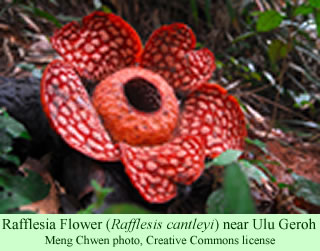The Semai, like many peaceful societies, are trying to preserve the best of their traditional culture while they seek various approaches to modernizing their lives. A crew from the China Central Television (CCTV), the national TV station of the People’s Republic of China, visited Ulu Geroh in Malaysia last week to prepare a story on the ways the Semai are preserving the old and adapting to modernity.
 Ulu Geroh, a village of about 400 people, has been in the news repeatedly since 2005 due to its successful tourist business. Villagers take visitors to see Rafflesia blossoms, the world’s largest flowers, and the exotic Rajah Brooke Birdwing butterflies where they congregate at wet spots in the nearby forests.
Ulu Geroh, a village of about 400 people, has been in the news repeatedly since 2005 due to its successful tourist business. Villagers take visitors to see Rafflesia blossoms, the world’s largest flowers, and the exotic Rajah Brooke Birdwing butterflies where they congregate at wet spots in the nearby forests.
The storyline for the two and a half minute video translates the comments of a rather young looking village man, named Syarni Saavi, speaking about the types of cures offered by the village healer, called a Bomoh.
“I believe my elder villagers can cure me with magical spells, chasing away evil spirits with our traditional ways. With my leg injury such as this, I’ve never been to a clinic, never been to a hospital, only my Atuk can cure me to recovery,” the man said, referring to Bah Aman, the 76 year old village healer who is evidently helping him recover.
We see a villager using a blowgun to shoot a tree squirrel, then some of the famous butterflies fluttering over a forest floor seep. Sani Boh Chidi, who is 20, earns an average of 16 Malaysian Ringitts (US$ 5.00) per day collecting rattans and selling them. But he would like a change in his life. He carries a bundle of bamboo stalks to his house, sets them down and says, as translated by the Storyline, “I like most to stay in the city, because in the city, there are a lot of special things, and we can earn money easily. We can get a lot of things that we like.”
But the final scene provides a contrast. It shows an older villager, Ngah Sidin Hamazah, naked from the waist up, sitting in a village house and telling CCTV about the traditional Semai dances. At 73 years old, he has witnessed a lot of modernization over the past decades. He has been the village chief for 20 years, and he is more interested in preserving the best of the old ways.
The storyline indicates that the guides who take tourists to see the natural places donate most of their earnings to the Village Development Fund, which helps their efforts to protect their forest. The video closes with shots of village children boarding a school bus at 6:00 AM to go to a primary school 11 km away, or a secondary school about 20 km away. The young people hope to be able to get good educations.
China Network Television (CNTV), the branch of CCTV that offers programming for the Web, offered its own variation last week on the visit to Ulu Geroh with a much more effective, longer video. The opening dance, unexplained in the CCTV video, is called the Sewang. It is not performed to welcome guests or to highlight a festival. Rather, it is a dance that calls on the Guarding God for healing.
The CNTV video makes a number of significant points that the shorter presentation skipped. The narrator, who speaks excellent English, says that in addition to earning money from their tourists, the villagers hunt, gather forest products, and practice slash and burn agriculture.
Their homes, made of wood and bamboo, are simple, traditional structures, with the living quarters above ground floors that are inhabited by chickens and dogs. The main floor of each dwelling has one room, which serves as bedroom, kitchen, and sitting room. People eat their food with their fingers, the narrator says, only using utensils to portion out foods when they have guests.
The CNTV production, an interesting, professional video, may not go viral on the Internet, but nevertheless it is a brief, worthwhile examination of the critical issue that faces all traditional societies: how much to preserve old ways and whether to embrace modernization.